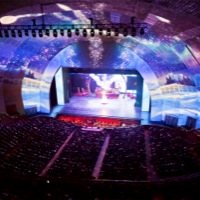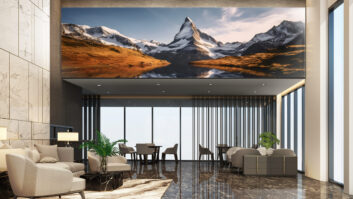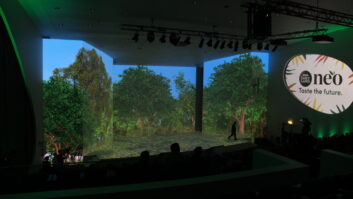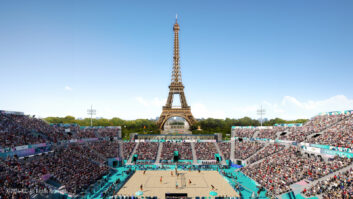
The market for projectors at or above Full HD (1080p) and WUXGA (1,920 x 1,200) resolutions is growing, not only in the consumer and digital markets but in the pro-AV sector too. “Everybody just wants more pixels – the pro-AV market in particular, in control rooms or visualisation sites, perhaps where multiple windows from various sources need to be seen side by side at full resolution,” explains Matthew Brennesholtz of consultancy Insight Media, which organised the recent Megapixel Summit at ISE 2013. “Sometimes they don’t realise what they need the pixels for until after they have installed them and then they wonder how they lived without them!”
Jeffrey Liang, director of business line management at BenQ Europe, cites recent industry data. “We can see from FutureSource data that the 2011-12 year-on-year growth is 36.3% and the share of total available market is 1.2% to 1.6%.” He sees high-resolution projectors as of particular interest to the areas of public display and cinema.
High resolution is migrating from the high-end, large-screen market towards lower brightness categories, according to Hartmut Kulessa, marketing manager for projector products at Panasonic Europe. “We now have 1080p and WUXGA products all the way down to the 4,000- and 5,000-lumen category. Whenever we have a new installation in corporate, education or digital signage, 95% of customers ask for high-resolution straight away. Our XGA and WXGA options are mostly used for replacement installations.”
Alan Dempster, Canon’s European projector specialist, says WUXGA is sought after for high-end projector and monitor purchases and has become the de facto standard for high-end IT/AV environments. “The fact that WUXGA can do both computer and video makes it a very versatile resolution.” He lists specialist simulation companies, military or medical applications, designers, engineers, photographers, corporate boardrooms and higher education facilities such as tech colleges as likely installations for Canon’s WUXGA XEED projectors.
New solutions for the business and education markets keep emerging. projectiondesign responded to the market needs for higher-resolution imaging by introducing projectors like the F35 panorama and F35 WQXGA projectors. A spokesman for the company explains: “Our customers demand these resolutions for their specific markets and applications. Introducing our ultra-high resolution projectors has opened up new markets for us.” These were shown at ISE 2013, as was Mitsubishi’s new 4,100-lumen WUXGA UD740U projector.
Tom Bert, product marketing manager of digital cinema at Barco, says the search for the best possible image quality is what ultimately drives customers and end-users. “Resolution is just one of many factors contributing to image quality. Over the past years and decades, we have seen brightness, contrast, colour gamut and resolution all advance. As new technologies mature and enable new applications, they are adopted. The same is true for high resolution, but not at a higher pace than the other parameters.” The rise of 4KMeanwhile the 4K market segment is growing in popularity thanks to increased adoption by the film industry, according to Tak Nakane, product manager at Sony Professional. “While the technology is currently being used solely for entertainment purposes, 4K resolutions have a great deal of potential in the B2B sector, in terms for example of the ability to increase image size without sacrificing quality across a wide range of business applications.”
The influence of 4K in this market is not yet clear, but a lack of available content is universally raised as the main stumbling block. Øivind Solli, service and product manager for large venues at Vivitek Corporation, says that while he believes Full HD and WUXGA are increasingly important, he doesn’t think the market is ready for the likes of 4K. “It doesn’t help when the cost is high, content not available and source graphic hardware is still expensive and rare.”“4K has become a buzz in the industry despite the distinct lack of content; perhaps it’s more of an insurance policy in some clients’ minds,” reflects Ciaran Doran, head of international sales and marketing at Digital Projection. “Markets will often gravitate to the highest resolutions possible while striving for bigger and better images. However while we all may work towards a 4K future, there are many other detailed elements within video processing that can make a real difference in the image quality deliverable today.”
Axel Kutschke, product manager and head of B2B sales at Hitachi, says that from a manufacturer’s perspective there is a margin to be made in 4K. Over time, he believes the market will grow overall, even when prices start to fall as popularity increases. “In the absence of 4K content, projector manufacturers will need to consider ways to upscale 1080p or even standard-definition content, should there be demand for it.” High Frame Rate (HFR)Bert at Barco says that in the cinema industry, which has used 24fps for a long time and where 3D is mature, HFR has been the ‘talk of the town’ and pushed by content creators for some months. “The focus of the discussion has been on doing 3D content at frame rates beyond 24fps, with 48fps and 60fps per eye being discussed. In other industries, HFR 3D is not as important a topic.”
Indeed, Kulessa at Panasonic says the company has not been facing requests for higher frame rates. “People want good-quality connections, like using HD-SDI when they use a WUXGA projector. It’s not that people specifically ask for HFR or an HD-SDI connection when they first look into products for their application. The first concern is resolution.”
Yet HFR is important in certain market segments, according to Doran at Digital Projection. “We are certainly seeing some of the more discerning clients requesting frame rates that enable them to achieve image qualities that reproduce real-life environments in simulation, visualisation, healthcare and research situations.”
“Our projectors can be upgraded with our X-PORT extension modules for use with systems that need to process high frame rates; this is particularly relevant for stereoscopic work,” according to projectiondesign. “One of the modules works as an image processor and frame rate converter capable of frame converting any input signal or combination of signals to sequential 120Hz, essential for many applications with fast-moving objects or 3D stereo visualisation.” Solid stateThe main benefit of solid-state illumination (SSI) is its long-term cost-effectiveness but it doesn’t yet deliver the brightness that is often required for high resolution, according to many. Liang feels that high-usage, heavy-duty markets like education can see the value for SSI, when the pricing hits the sweet spot. Kutschke also thinks education may be the first to adopt solid state, due to pressure to purchase units with a low TCO.
Nakane agrees that budgets for AV in corporate and education environments are key when it comes to decision making and that SSI dramatically lowers the cost of ownership. “Content viewed in the classroom and the boardroom is moving beyond traditional PowerPoint slides and the perfect reproduction of both pictures and colour is increasingly important, even in ambient light conditions. As a result, sectors like corporate and education are most likely to be early adopters of solid-state technology.”
“We’ve already completed several installations of solid-state projection at visitor attractions, civil aviation and infrared night vision goggle stimulation in simulation and training,” says projectiondesign. L-3 Link Simulation and Training’s Boeing 777 full-flight simulator uses the company’s FL35 ReaLED projector series, meeting the stringent imaging requirements for Level D certification.
However Brennesholtz cautions that solid state doesn’t yet offer the light levels needed for many large-screen, high-resolution installs which still use lamps above 5,000 or 6,000 lumens, “especially if there’s an ambient light in the room, which is often needed for note-taking in certain environments,” he cautions.
Software is increasingly being used to support high-resolution projection. Solli from Vivitek lists warping, advanced keystone corrections/corner correction, edge-blending, presentation shows, projector plotting/mapping, interactivity, touch control and colour calibration as examples of where software can enhance the experience of using a projector and support the completion of extremely complex adjustments in a matter of minutes instead of hours.
Kutschke says he has seen a greater need to deliver interactivity, especially in relation to corporate meeting environments. “We have just launched our own quick-connection app and now offer a wide range of other connectivity options. Compatibility across different platforms will also influence buying decisions as will direct connection to the Cloud.”
“Of course, functionality in any high-end niche technology environment will progress towards software solutions in replacement of hardware applications that are more expensive to produce or update,” comments Digital Projection’s Doran. “However, there comes a point with projection where the physical simply cannot be replaced.”Liang feels that installation flexibility is another growing trend in the high-brightness market. “People are looking for more cost-effective solutions; for example a one-time installation in the auditorium of a school will require a projector with 6,000+ ANSI lumens and high resolution. As long as the projector can be installed flexibly so that the zoom ratio is good enough to cover 90% of usage, then the school doesn’t need to buy the projector with an expensive optional lens.”
Dempster explains that when XEED was first brought to market, customers wanted to change the lenses and use long zoom lenses or wide lenses at times. “We introduced an interchangeable option, another way to give customers the versatility to adapt the product to any environment, always focused on quality. If you have a high-resolution projector with lots of pixels, it’s a pity if the final image is compromised by a poor-quality piece of glass.”
At ISE, Panasonic demonstrated an ultra short-throw exchangeable lens for high-brightness, high-resolution projectors, which permits the projector to be placed underneath or above the screen or to provide very short distance rear-projection. This allows the creation of large-screen applications in compact spaces. The prototype will be brought to market in August.
HDBaseT connectivity is also likely to become significant in the future, according to both Liang of BenQ and Solli of Vivitek. “It not only offers great digital signal quality to the displays over long distances, but it is also cost-efficient to install compared with existing standards of VGA, HDMI and DVI,” says Solli.
Finally, Brennesholtz says the high-resolution projection market is feeling the competition from direct view displays in environments such as conference rooms, where LCD is winning over projectors in the case of 60in screens and below. “Direct view is also giving projection a run for its money in the 60-90in range and, if you have enough money, in sizes up to about 150in,” he says.
Dempster feels that in ‘always-on’ environments, panels are favoured for smaller displays. “For a single large display however, anything over 60in, certainly over 100in, it’s too difficult to use panels. It’s possible but still neater to use front or rear image projection and I don’t expect that to change in the near future.”
“The projector industry got quicker competition from panel makers than was thought to be possible,” agrees Solli. “The main driver is that the cost of panels up to 50-70in has come down dramatically as their quality increased. There are good and bad arguments for both types of displays, so it’s up to the reseller and end-user to decide what fits best in their room.” www.barco.comwww.benq.euwww.canon-europe.comwww.digitalprojection.co.ukwww.hitachidigitalmedia.comwww.insightmedia.infodisplays.mitsubishielectric.eubusiness.panasonic.co.ukwww.projectiondesign.comwww.sony.co.ukwww.vivitek.eu







